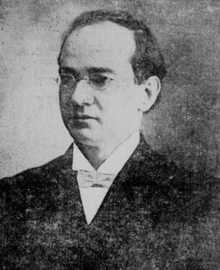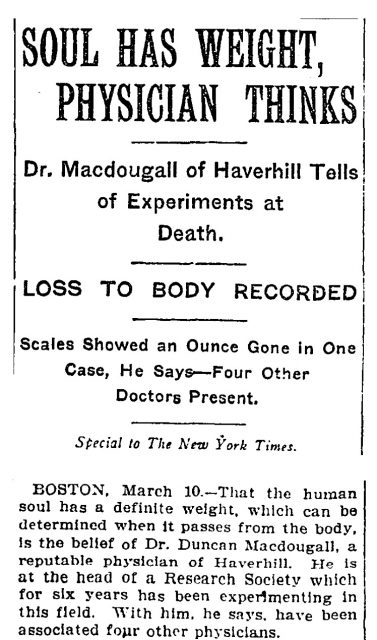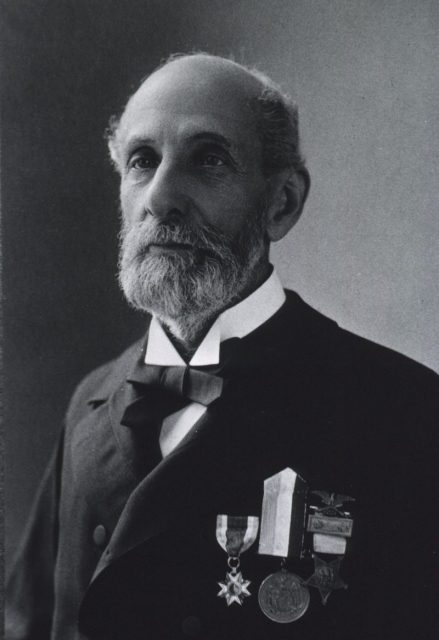In 1907 a study was published which blurred the boundaries of science and the supernatural. An American physician wanted to prove that Mankind had a soul.
To do this, Duncan MacDougall employed means that were practical to some and absurd to others. He decided he was going to try and weigh the soul.
By showing it could be measured like any other material, he hoped to unlock the secrets of human existence. He actually referred to it as a “soul substance.”
The study began in 1901. Using 6 test subjects that had been specially selected, MacDougall altered their hospital beds so they rested on beam scales. Naturally, he wanted a high degree of accuracy, and beam scales gave him the degree of precision he needed.

The patients were reportedly found in nursing homes. Most of them had tuberculosis, a significant if morbid detail for MacDougall, who wanted his exhausted subjects to be still so as not to disturb the scale when they passed on.
As described in a 2015 blog post for Discover Magazine, “He recorded not only each patient’s exact time of death, but also his or her total time on the bed, as well as any changes in weight that occurred around the moment of expiration. He even factored losses of bodily fluids like sweat and urine, and gases like oxygen and nitrogen, into his calculations.”
Six years on, the findings were revealed to an intrigued public in the publication American Medicine, alongside coverage in the New York Times.

MacDougall’s startling conclusion was that the soul weighed 21 grams, or three-fourths of an ounce.
In reference to one case, MacDougall told the Times, “The instant life ceased the opposite scale pan fell with a suddenness that was astonishing — as if something had been suddenly lifted from the body.”
The news was treated with a degree of skepticism by his contemporaries. In particular, the physician Augustus P. Clarke countered that the missing grams were a natural process, owing to the body’s sweating after death due to higher blood temperature.

MacDougall disputed this, and even went on to claim that a patient’s outlook played a role in the study. Citing a “remarkable” incident in the Times, he mentioned a subject of “larger physical build, with a pronounced sluggish temperament” who didn’t display any change in weight for a “full minute” following his demise.
The weight then suddenly dropped. MacDougall concluded that the soul “of a phlegmatic man slow of thought and action… remained suspended in the body after death, during the minute that elapsed before it came to the consciousness of its freedom.”

Despite receiving criticism for his ideas, MacDougall also had his supporters. While the scientific value of his study is in doubt, some commentators point to the nebulous nature of research in the first place, and that there’s still so much, experts don’t understand.
He went on to try and photograph the soul. According to Discover Magazine, he “did manage to perform a dozen experiments in which he photographed ‘a light resembling that of the interstellar ether’ in or around patients’ skulls at the moments they died.”
Discover believes his findings hold sway today because they point at life’s mystical qualities, as well as its rational ones. It writes, “MacDougall’s work resonated, and continues to resonate, not because of what he found (or failed to find) but because of what he suggested.”
The concept of a soul having weight fired the imaginations of filmmakers and authors. Respected director Alejandro González Iñárritu (The Revenant) made 21 Grams starring Benicio del Toro, Sean Penn and Naomi Watts in 2003. Later in that decade, Dan Brown’s The Lost Symbol featured MacDougall’s story.
Read another story from us: Vienna 1913 – Home of the Dictators who Shaped the 20th Century
Ultimately MacDougall’s research reaffirmed faith in the unknowable, as well as that which is known. “The experiments’ actual results,” Discover writes, “and their failure to achieve acceptance as scientific canon, are entirely beside the point. Science has gone one way, and pop culture another.”
